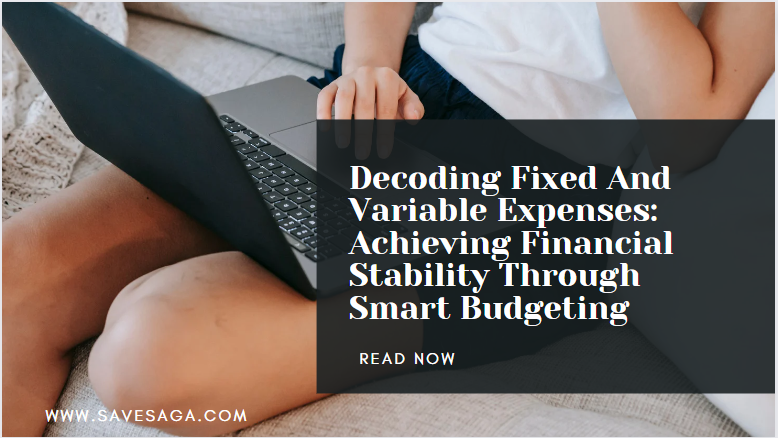Master the art of financial stability with our guide on budgeting. Explore the balance between fixed and variable expenses for flexibility and control.
Introduction
In the intricate dance of personal finance, understanding the dynamics between fixed and variable expenses is paramount. As we navigate the labyrinth of budgeting, it’s crucial to discern the nuances that differentiate these two financial elements.
Defining Fixed Expenses
Fixed expenses are the bedrock of our financial commitments. These are the regular, unchanging payments we make, such as mortgage or rent, insurance premiums, and subscription services. These steadfast obligations form the financial infrastructure of our lives.
Here are some examples of fixed expenses:
- Mortgage or rent
- Gym memberships
- Most insurances like 401k
- Streaming services
- Phone bill
- Internet
- Subscriptions
- Day care
Unveiling Variable Expenses
On the other hand, variable expenses are the dynamic, ever-shifting components of our financial landscape. Groceries, dining out, entertainment, and other discretionary spending fall under this category. Unlike fixed expenses, these costs can fluctuate, presenting both challenges and opportunities for financial flexibility.
Here are some examples of variable expenses:
- Water
- Electricity
- Eating out
- Date nights
- Groceries
- Entertainment
- Gasoline
- Car repairs
- Medical bills
- Copays
Budgeting for Fixed and Variable Expenses: A Two-Pronged Approach
To effectively budget for fixed and variable expenses, it’s essential to adopt a two-pronged approach:

Fixed Expenses: Planning with Precision
For fixed expenses, the process is relatively straightforward. Gather your recent bank statements or bill records and identify all your recurring expenses. Determine the exact amount due for each expense and allocate the corresponding funds in your budget.
Variable Expenses: Embracing Flexibility
Variable expenses require a more flexible approach. Start by tracking your spending habits for a few months to get an accurate picture of your average outlays. Categorize your variable expenses into groups like groceries, entertainment, and transportation. Based on your spending patterns, set realistic monthly limits for each category.
The 50/30/20 Rule: A Guiding Framework
The 50/30/20 rule provides a handy framework for allocating your income across fixed, variable, and savings categories:
- 50%: Needs Allocate 50% of your income towards fixed expenses, such as housing, transportation, and utilities.
- 30%: Wants Use 30% of your income for variable expenses, such as dining out, entertainment, and shopping.
- 20%: Savings Dedicate 20% of your income towards savings and debt repayment.
Regular Review and Adjustments: The Key to Success
Your budget is not a static document; it’s a dynamic tool that needs regular review and adjustments. As your income or expenses change, revisit your budget and make the necessary modifications. Remember, budgeting is an ongoing process that empowers you to take control of your finances and achieve your financial goals.
Difference between fixed and variable expense
Here’s a detailed table highlighting the differences between Fixed and Variable Expenses:
| Aspect | Fixed Expenses | Variable Expenses |
|---|---|---|
| Definition | Regular, unchanging payments that recur consistently. | Dynamic, fluctuating costs that can vary month-to-month. |
| Nature | Stable and predictable. | Unpredictable and subject to change. |
| Examples | Mortgage or rent, insurance premiums, utilities, subscriptions. | Groceries, dining out, entertainment, travel, clothing. |
| Frequency | Typically monthly. | Can vary, often incurred more sporadically. |
| Control | Limited control over the amount. Often fixed by contractual agreements. | Greater control, as spending can be adjusted based on lifestyle and choices. |
| Flexibility | Less flexibility in adjusting the amount spent. | More flexibility, allowing for adjustments based on circumstances. |
| Essentiality | Essential for maintaining a stable lifestyle (e.g., housing, insurance). | More discretionary and non-essential in nature. |
| Planning | Easier to plan for, as amounts remain relatively constant. | Requires more dynamic planning due to potential variations. |
| Budgeting Focus | Forms the core of a budget, providing a foundational structure. | Requires ongoing attention and fine-tuning within a budget. |
| Impact on Savings | May limit flexibility in saving due to fixed commitments. | Offers more potential for savings through conscious spending choices. |
| Financial Stability | Provides stability and predictability in financial planning. | Adds an element of adaptability to financial plans. |
| Emergency Preparedness | Offers stability but may limit immediate flexibility during emergencies. | Provides more room for adjustments during unexpected events. |
| Risk Tolerance | Lower risk due to predictability. | Higher risk due to potential fluctuations. |
This comprehensive table outlines various aspects that distinguish fixed expenses from variable expenses, helping individuals understand and manage their financial commitments more effectively.
The Importance of Budgeting
Creating a budget is akin to crafting a financial roadmap. It guides us in allocating resources effectively, ensuring that our financial ship sails smoothly. To master this art, we need to understand the delicate equilibrium between fixed and variable expenses.
Taming Fixed Expenses
1. Housing Costs
When examining fixed expenses, housing often takes center stage. Whether you rent or own, optimizing housing costs is pivotal. Evaluate your mortgage or rent, considering refinancing options and exploring housing alternatives if needed.
2. Insurance Strategies
Insurance is a non-negotiable fixed expense. However, the savvy financial navigator explores different insurance providers, tailoring coverage to individual needs. Regularly reviewing policies can unearth potential savings without compromising protection.
Navigating Variable Expenses
1. Grocery Shopping Tactics
In the realm of variable expenses, groceries offer a significant battlefield. Strategize your grocery shopping, embrace meal planning, and be open to store brands. Small changes here can yield substantial savings over time.
2. Entertainment in Moderation
Variable expenses often lure us with the promise of instant gratification. While occasional indulgences are essential, a mindful approach to entertainment expenses ensures that leisure doesn’t sabotage financial goals.
Embracing Perplexity and Burstiness
Navigating the intricacies of fixed and variable expenses requires an acknowledgment of perplexity and burstiness. Embrace the complexity of financial decisions, understanding that bursts of spending can coexist with the need for predictability in certain financial obligations.
Engaging the Reader: A Conversational Approach
As we delve into the world of financial dexterity, let’s approach this discussion with a conversational tone. We, as financial explorers, understand the perplexities you may face. Let’s unravel the complexities together.
The Active Voice in Finance
When discussing fixed and variable expenses, we employ the active voice to empower you. We analyze, we strategize, and we guide. This is not a passive journey but an active partnership in your financial expedition.
Analogies and Metaphors
Imagine your budget as a sailing vessel, with fixed expenses acting as the sturdy anchor and variable expenses as the sails that catch the winds of financial opportunity. Balancing both ensures a smooth voyage toward financial stability.
Get a budgeting app
Consider using a budgeting app to simplify the entire process — from planning and tracking to adjustments. My top recommendation? EveryDollar. It’s the go-to budgeting tool for my family, and the best part is, you can begin using it for free today.
Keep in mind, you don’t need to be a financial guru to handle your money wisely. What matters is being intentional. Take the time to create and consistently maintain a budget for both your fixed and variable expenses every month.
Conclusion
In the symphony of financial planning, fixed and variable expenses harmonize to create a melody of stability and flexibility. Striking the right balance is an ongoing process, an art that transforms financial management into a seamless dance.
FAQs: Navigating the Financial Seas
Free Invoice Template for Excel: Streamline Your Billing Process
In the fast-paced world of business, efficiency and accuracy in billing are paramount. At SaveSaga,…
20+ Budget-Friendly Gift Ideas for Every Special Occasion
Unlock the secret to heartfelt gifting without breaking the bank. Explore our guide for creative,…
30+ Ways to Make $1000 Fast in 2024: Legal, Legit, and Lucrative
#MAKE MONEY Make $1000 fast Are you struggling to make ends meet? Do you need…
How to Create a Budget as a College Student, 13 best ways
In the whirlwind of college life, Budget as a College Students can be a daunting…
8 Proactive Strategies On How To Protect From Inflation For Financial Stability
Explore proactive budgeting and investment strategies on how to protect from inflation and to maintain…
Decoding Fixed And Variable Expenses: Achieving Financial Stability Through Smart Budgeting
Master the art of financial stability with our guide on budgeting. Explore the balance between…





Pingback: Mastering Your Money: The Ultimate Guide To Budgeting Success
Good
Decoding Fixed And Variable Expenses: Achieving Financial Stability Through Smart Budgeting